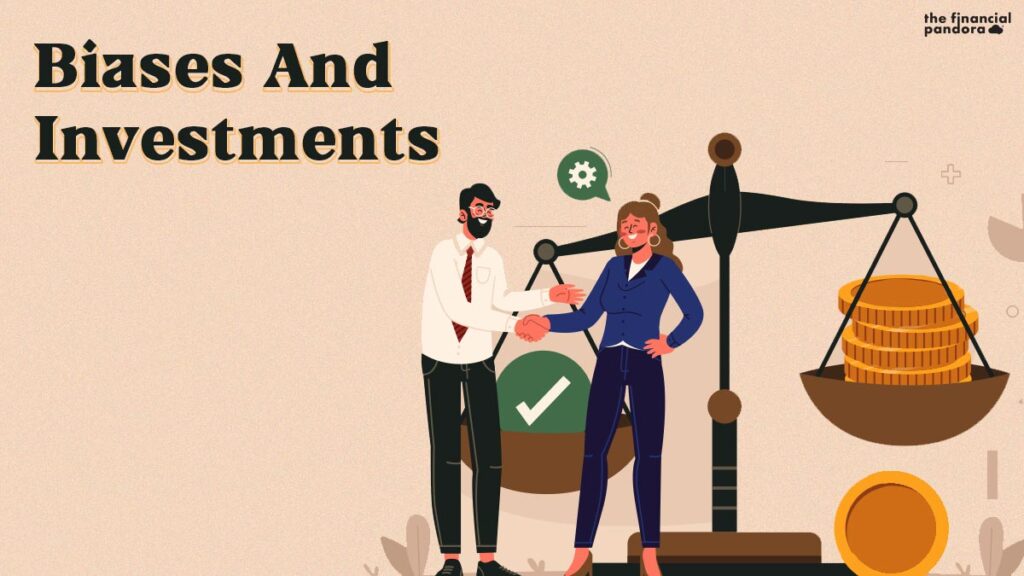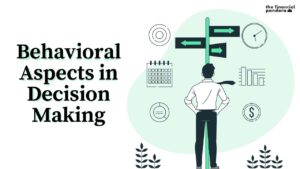Las Vegas is busy every day, so we know that not everyone is rational.
– Charles Ellis
Over the years, the study of investment decisions has helped the market identify the distinction between traditional and behavioral finance concepts. When discussing the two, the former revolves around the theoretical concepts of optimal decision-making with an utterly rational mindset. The latter deals with the actual behavior of “normal” individuals who make suboptimal choices by taking irrational steps.
Today, the deviation from scientific precision while making decisions is justified with a deeper understanding of the limitations of human behavior. Investment decisions are a perfect example of the relative rationality of humans. Behavioral finance, therefore, helps individuals, as well as investors, understand what drives market participants to act how they do. It revolves around the ideology of accepting these limitations and then aiming to generate better financial results. Another part of behavioral finance deals with modifying behavior according to situations. One of the concepts commonly used in behavioral finance is the analysis of decision-making by Howard Raiffa (1997). He discusses three main categories of analyzing decision making, namely the normative approach (rational solution), the descriptive approach (how individuals make decisions), and the prescriptive approach (methods or tools which help individuals to achieve the closest to optimum solutions). Now, behavioral finance is a mix of the descriptive and prescriptive approaches. The basis of financial decision-making in individuals remains in the understanding of the person’s heuristics and biases. These are forces that come into the picture and the person’s formal knowledge about the field.
Here, it is essential to understand the concept of efficient and inefficient markets. In an efficient market, it is believed that all the information has been incorporated into the price of the asset or investment. However, this is only a hypothetical scenario. In reality, markets are highly inefficient, primarily because everyone knows not everything. The participants in this market are humans or computers that are programmed by human beings. Regardless of how disciplined, people often make financial decisions colored by their own behavioral biases that cause them to act emotionally or make mistakes while processing information.

Broadly, there are two categories, cognitive errors and emotional biases, in which one can segregate these biases in. One being cognitive errors or biases and the other being emotional biases. The former are easier to identify and can be worked on, whereas the latter can be challenging to overcome. The term “overcoming” is directed towards the capacity of an individual to address the negative influence of these biases on their financial decisions.
Cognitive Errors
These usually occur due to the limited nature of information processing by individuals, incorrect statistical conclusions, and errors in human memory. Here is a look at common cognitive biases often found in retail investors and individuals handling funds for larger institutions.
- Confirmation Bias
It is a widespread phenomenon notable in investors. In this case, the individual pays attention to or instead consumes knowledge that favors his existing opinion. They unknowingly ignore facts or data that refute them; this may skew the value of their decisions based on their own cognitive biases. Frequently investors end up making uninformed choices, and this may add on some unnecessary risk.
You have a company in mind that you like and wish to invest in the same. While doing your research about its operations, financial health, management, etc., there is a high possibility that you will pay more attention to information favoring your decision rather than figures or details that may indicate something wrong with the company. This is when your existing opinion of the company comes into the picture. Thus, what you are experiencing is nothing but an example of confirmation bias.
- Hindsight Bias
It is when one sees past events as having been easily predictable and even reasonable to expect. It means that an investor believes that they have accurately predicted the occurrence of an event after it occurs. They, as a consequence, develop overconfidence in their ability to predict other future events and may lead to some risky decisions which could be easily avoidable. One can consider the aftermath of the pandemic as an easy example. Many market participants felt that they already had a sense of the gravity of the pandemic effect and how the recovery path is what they had expected it to be like. But the truth of the matter is that this was not something that could’ve been easily predicted.
- Framing Bias
It means that an investor responds to information in the way presented to him. If the structure or the manner of delivery is changed, then his response to the same changes. In this scenario, the way the information has been presented is of more importance than the actual content. At times, this leads to choosing suboptimal options.
To understand this further, read the following lines.
“There is a 30% chance that the account operating fees will be increased.”
“There is a 70% chance that the account operating fees will not be increased.”
Here both of the statements mean the same, but the reaction to each of them will be different.
- Availability Bias
It is when an individual takes a heuristic approach to estimate the probability of an outcome based on how comfortably that outcome comes to their mind. Information and concepts that are understandable and easy to remember are always fresh in mind and can be recalled easily. It is a common occurrence when an individual is building their portfolio. They may fail to diversify or limit their investments. For example, imagine you recently spent a considerable amount of time reading about different kinds of investment avenues and, in the process, saw multiple advertisements regarding mutual funds. Now, the next time someone asks you about investments, you will unknowingly lay stress on mutual funds.
- Emotional Biases
The origins of these biases lie in the personal feelings and emotions of the investor. They are fueled by magnified human emotions like fear, excitement, thrill, and so on. Identifying and correcting them can often be difficult as they are complex, and the solution is not always clear as black and white compared to cognitive errors. Below is a list of some emotional biases experienced by investors quite often.
- Loss Aversion Bias
It is directed towards the idea that the degree of pain or discomfort experienced due to a loss is far more than the degree of joy when experiencing again. We as humans tend to avoid situations or decisions that would guarantee a negative result or have a possibility of not working out. There is a constant urge to avoid losses and, therefore, ultimately avoid the pain caused by it. A typical example of loss aversion is when people hold on to investments or at times sell them quickly to avoid situations that may have a possibility of not behaving in their favor.
- Overconfidence Bias
As the name suggests, overconfidence Bias is based on the heightened faith that an individual may have in their ability or intuition. In this case, the person’s ability to judge and the reason is ruled by his personal opinions and knowledge. He may feel he is right all the time, but that is not the case generally. This is a classic case; they underestimate their risks’ existence or degree and simultaneously overestimate the behavior and level of expected returns. This often leads to poor decision-making and, at times, makes people trade excessively.
- Self-control Bias
It deals with the person’s individual incapacity to control themselves and not act in the best interest of their plans. This is usually due to a lack of discipline and responsibility. In such cases, there is a possibility of accepting excessive risk and making way to asset misallocation in the portfolio. Today, many of us in the younger generation is witness to such acts of failing self-control. New income earners tend to go overboard with attractive paychecks with minimal left for savings and emergencies.
- Status Quo Bias
It is when a person or, more aptly, a dormant investor makes no changes to his investments. They may ignore them, be too bored to take the decision or forget about it altogether. In times like this, they tend to miss opportunities and fail to understand the dynamic nature of investments over long-term cycles. Status quo bias can cause investors to invest in the same type of securities they always invested in. For example, suppose an investor is comfortable investing in debt instruments. In that case, he may continue to do so even though the risk-weighted returns from equity might help him achieve his financial goals faster in the long run.
- Endowment Bias
As the term suggests, Endowment Bias is linked to passive income or wealth or an asset that may have been received from another person. Here, people value an asset more when they hold rights to it than when they do not. Simply put, we tend to value assets or things in our possession slightly higher than their value in the market. Research has identified “ownership” and “loss aversion” as the two main psychological reasons causing the endowment effect. A very relatable example of this can be when people are reluctant to sell off assets that have been handed down by earlier generations or are gifts from people around them.
On a broader level, these are some basic concepts about biases that one needs to be aware of if they are actively investing or looking to invest. Further on, detailed studies have been undertaken to understand the effect of this dynamic cognitive behavior during various market periods and specific to various asset classes. In addition to this, with more advanced research, many investment firms use these biases to understand client behavior and then incorporate the findings while recommending investment plans. But that is another area to deep dive into separately.
Our motive as retail investors is to understand ourselves, the market, and our behavior towards investing in general. An acknowledgment of these limitations and correcting them has fared better results than blindly continuing with existing strategies. We have seen bubbles form and crash; investment biases have a decisive role to play in them. Suppose you aptly understand your style and identify the ongoing sentiments of other participants. In that case, you are bound to protect yourself from unnecessary downturns and, at the same time, expose yourself to some good opportunities.
This post was written in collaboration with Asif Yahiya Sukri LLP. Asif Yahiya Sukri LLP provides unparalleled personalized financial services to a broad range of clients across different geographical locations. With a presence in the USA, India and the MENA region, they ensure that all of your financial decisions are made carefully and with your best interests in mind. They are innovators who understand what goes into building companies.
You can also reach out to them on info@aysasia.com
Follow Us @




